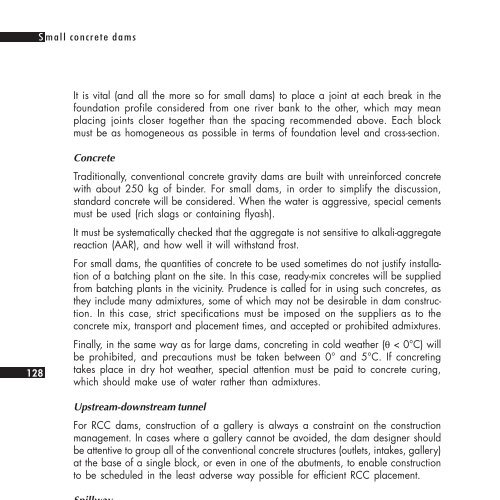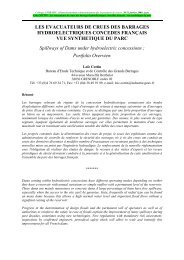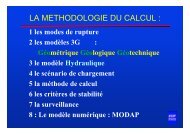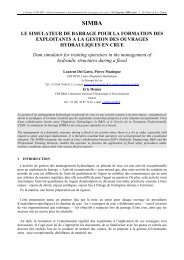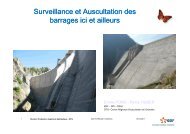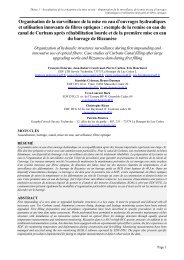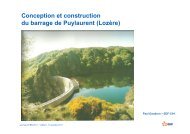SMALL DAMS
SMALL DAMS - Comité Français des Barrages et Réservoirs
SMALL DAMS - Comité Français des Barrages et Réservoirs
- No tags were found...
Create successful ePaper yourself
Turn your PDF publications into a flip-book with our unique Google optimized e-Paper software.
S mall concrete dams<br />
It is vital (and all the more so for small dams) to place a joint at each break in the<br />
foundation profile considered from one river bank to the other, which may mean<br />
placing joints closer together than the spacing recommended above. Each block<br />
must be as homogeneous as possible in terms of foundation level and cross-section.<br />
128<br />
Concrete<br />
Traditionally, conventional concrete gravity dams are built with unreinforced concrete<br />
with about 250 kg of binder. For small dams, in order to simplify the discussion,<br />
standard concrete will be considered. When the water is aggressive, special cements<br />
must be used (rich slags or containing flyash).<br />
It must be systematically checked that the aggregate is not sensitive to alkali-aggregate<br />
reaction (AAR), and how well it will withstand frost.<br />
For small dams, the quantities of concrete to be used sometimes do not justify installation<br />
of a batching plant on the site. In this case, ready-mix concretes will be supplied<br />
from batching plants in the vicinity. Prudence is called for in using such concretes, as<br />
they include many admixtures, some of which may not be desirable in dam construction.<br />
In this case, strict specifications must be imposed on the suppliers as to the<br />
concrete mix, transport and placement times, and accepted or prohibited admixtures.<br />
Finally, in the same way as for large dams, concreting in cold weather (θ < 0°C) will<br />
be prohibited, and precautions must be taken between 0° and 5°C. If concreting<br />
takes place in dry hot weather, special attention must be paid to concrete curing,<br />
which should make use of water rather than admixtures.<br />
Upstream-downstream tunnel<br />
For RCC dams, construction of a gallery is always a constraint on the construction<br />
management. In cases where a gallery cannot be avoided, the dam designer should<br />
be attentive to group all of the conventional concrete structures (outlets, intakes, gallery)<br />
at the base of a single block, or even in one of the abutments, to enable construction<br />
to be scheduled in the least adverse way possible for efficient RCC placement.<br />
Spillway<br />
The most common design for conventional concrete or RCC gravity dams consists in<br />
building a surface spillway (gated or ungated), in the central part of the dam. In<br />
order to dissipate a good part of the energy, a stepped chute is built on the downstream<br />
face, with conventional concrete 1 . The sill usually has a standard ogee shape. Steps<br />
are built as high up the chute as possible, and their height increases to 0.60 to 0.90<br />
metre in the central section of the chute.<br />
The steps may be built in situ, possibly using the technique of slipformed concrete<br />
(used at Riou dam) or may be built of pre-cast elements for RCC dams. When specific<br />
discharge on the chute is high, the steps must be anchored in the dam body.<br />
1. See Bibliography, reference 5, p. 139.


